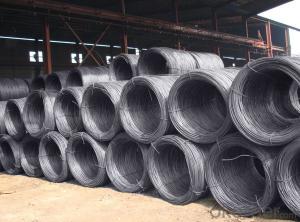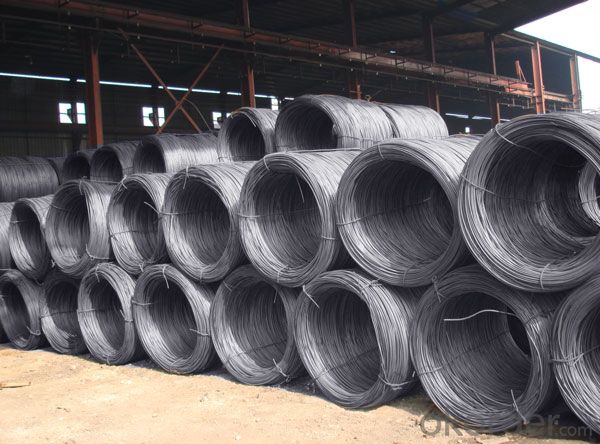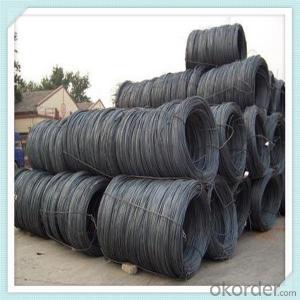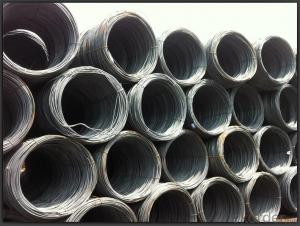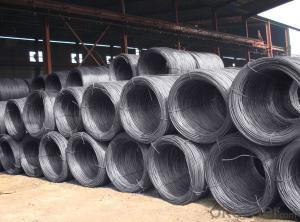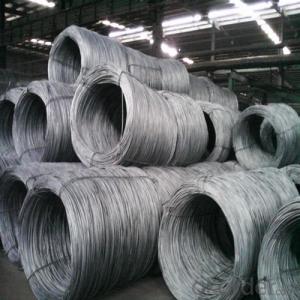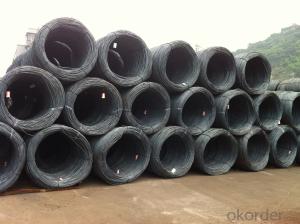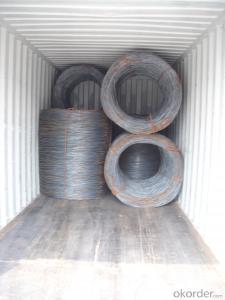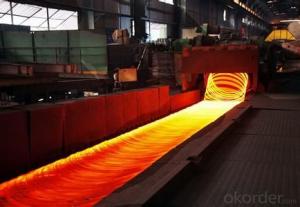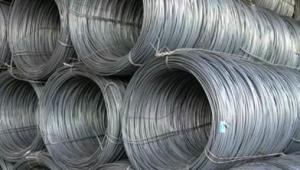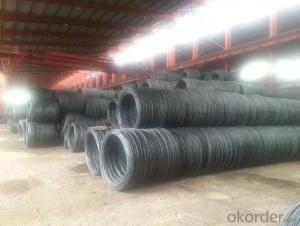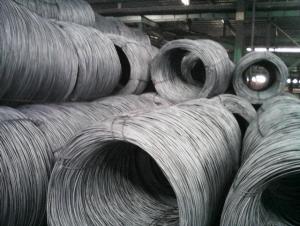Steel Wire Rod Hot Rolled SAE1008B in China
- Loading Port:
- Tianjin
- Payment Terms:
- TT or LC
- Min Order Qty:
- 27 m.t.
- Supply Capability:
- 20000 m.t./month
OKorder Service Pledge
OKorder Financial Service
You Might Also Like
Product Description:
OKorder is offering Steel Wire Rod Hot Rolled SAE1008B in China at great prices with worldwide shipping. Our supplier is a world-class manufacturer of steel, with our products utilized the world over. OKorder annually supplies products to European, North American and Asian markets. We provide quotations within 24 hours of receiving an inquiry and guarantee competitive prices.
Product Applications:
Steel Wire Rod Hot Rolled SAE1008B in China are ideal for structural applications and are widely used in the construction of buildings and bridges, and the manufacturing, petrochemical, and transportation industries.
Product Advantages:
OKorder's Steel Wire Rod Hot Rolled SAE1008B in China are durable, strong, and resist corrosion.
Main Product Features:
· Premium quality
· Prompt delivery & seaworthy packing (30 days after receiving deposit)
· Corrosion resistance
· Can be recycled and reused
· Mill test certification
· Professional Service
· Competitive pricing
Product Specifications:
1.commodity:steel wire rod
2.grade:Q195,SAE1008B-SAE1018B
3.diameter:5.5mm-14mm
4.type:in coil
5.coil weight:around 2 mt
Specification | Diameter: 5.5mm-14mm Weight of coils:50kgs or as your requirement |
Certificate | ISO9001-2008 |
Type | Low Carbon; Middle Carbon; High Carbon |
Material | Q195,Q215,Q235B,E235B,C45,C50,C55,C60,C65,C70,C75,65Mn,C72A,C72B,C80,C82B,SAE65,SAE70,SAE1006,SAE1008,SAE1010,SAE1015,SAE1018,65Mn,CT9A,GCr15, AND SO ON |
Kinds of Product | Spring Steel Wire; Cold -drawn Non-alloy Steel Wire For Springs;Carbon Steel Wires;Umbrellastand Wire; Steel Wires for Spoke; Mild Steel Wire for Important Purposes; Low Carbon Steel Wire for General Uses; Carbon Constructional Quality Steel Wires; Wire for Steel Wire Ropes Use; Galvanized Steel Wire rope; Copper Coated Steel Wire Rope etc. |
Tolerance | 1:Diameter: ±0.001 |
Tensile strength | 1400--3520 b/MPa |
Usage | Use for making Bed spring wire, Spring steel wire, Rope making wire, Tire wire, Spoke wire, High carbon steel wire, Low carbon steel wire, Cold drawn steel wire, Heat drawn steel wire, Free cutting wire, Border wire (may straightening and straight ruler) |
Packing | packing coil, plastic spool, reel bag, drum, carton and so on or according to the customer request |
trade term | FOB; CNF; CIF PORT: Xingang, Tianjin, China |
payment | T/T ,IRREVOCABLE L/C AT SIGHT |
delivery time | 1 week (1 container)after receipt of the T/T or L/C, depend on quantity |
Grade | Chemical composition table (%) | |||||
C | Mn | Si | S | P | B | |
SAE1008B | ≤0.10 | 0.3~0.50 | ≤0.15 | ≤0.050 | ≤0.040 | ≥0.0008 |
mechanical properties | ||||||
YAI (N/mm2) | Tensile Strength (N/mm2) | Elongation (%) | ||||
≥195 | 315-430 | ≥30 | ||||
FAQ:
Q1: Why buy Materials & Equipment from OKorder.com?
A1: All products offered byOKorder.com are carefully selected from China's most reliable manufacturing enterprises. Through its ISO certifications, OKorder.com adheres to the highest standards and a commitment to supply chain safety and customer satisfaction.
Q2: How do we guarantee the quality of our products?
A2: We have established an advanced quality management system which conducts strict quality tests at every step, from raw materials to the final product. At the same time, we provide extensive follow-up service assurances as required.
Q3: How soon can we receive the product after purchase?
A3: Within three days of placing an order, we will begin production. The specific shipping date is dependent upon international and government factors, but is typically 7 to 10 workdays.
Q4: What makes stainless steel stainless?
A4: Stainless steel must contain at least 10.5 % chromium. It is this element that reacts with the oxygen in the air to form a complex chrome-oxide surface layer that is invisible but strong enough to prevent further oxygen from "staining" (rusting) the surface. Higher levels of chromium and the addition of other alloying elements such as nickel and molybdenum enhance this surface layer and improve the corrosion resistance of the stainless material.
Q5: Can stainless steel rust?
A5: Stainless does not "rust" as you think of regular steel rusting with a red oxide on the surface that flakes off. If you see red rust it is probably due to some iron particles that have contaminated the surface of the stainless steel and it is these iron particles that are rusting. Look at the source of the rusting and see if you can remove it from the surface.
Images:


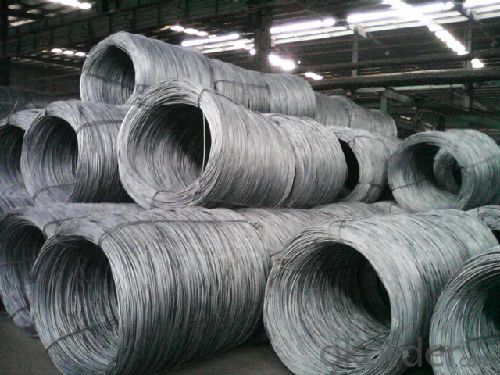
- Q: How is steel wire rod used in the manufacturing of wire forms for automotive exhaust systems?
- The manufacturing of wire forms for automotive exhaust systems heavily relies on steel wire rod. These wire forms are essential for providing structural support and stability to the exhaust system, ensuring its optimal functioning and long lifespan. To begin with, steel wire rod is employed to construct the primary framework of the wire form, which serves as the backbone of the exhaust system. This framework is responsible for securely holding and positioning various components of the exhaust system, including the muffler, catalytic converter, and pipes. The remarkable tensile strength and durability of steel wire rod make it an ideal choice for this purpose, as it can withstand the intense vibrations, heat, and pressure that the exhaust system encounters. Furthermore, steel wire rod is utilized to shape the hangers and brackets that fasten the exhaust system to the vehicle's chassis. These hangers and brackets are crucial for maintaining the correct alignment and stability of the exhaust system, preventing any unnecessary movement or rattling. The flexibility and malleability of steel wire rod enable it to be easily formed into the desired hanger or bracket design, ensuring a precise fit and dependable performance. Moreover, steel wire rod is also employed in the fabrication of wire mesh screens and filters that are installed within the exhaust system. These screens and filters play a vital role in trapping and eliminating contaminants, such as particulate matter and harmful gases, from the exhaust gases before they are released into the environment. The exceptional strength and corrosion resistance of steel wire rod make it an excellent choice for constructing these screens and filters, as they must endure harsh operating conditions and exposure to corrosive elements. In conclusion, steel wire rod plays a critical role in the manufacturing of wire forms for automotive exhaust systems. Its impressive tensile strength, durability, flexibility, and corrosion resistance make it the ideal material for constructing the main framework, hangers, brackets, and screens/filters within the exhaust system. By utilizing steel wire rod, manufacturers can ensure that the wire forms provide the necessary structural support, stability, and reliability required for the proper functioning of automotive exhaust systems.
- Q: What are the common industry standards for steel wire rod distributors?
- The common industry standards for steel wire rod distributors typically include specifications regarding the chemical composition, mechanical properties, dimensions, surface quality, and packaging of the wire rods. These standards are set by organizations such as the American Society for Testing and Materials (ASTM), International Organization for Standardization (ISO), and various national and regional regulatory bodies. Compliance with these standards ensures that the wire rods meet the required quality and performance criteria, and facilitates seamless integration into different industries that rely on steel wire rods for their manufacturing processes.
- Q: What are the major growth strategies adopted by companies in the steel wire rod industry?
- Companies in the steel wire rod industry utilize various strategies to expand their market share and increase profitability. Some of the key strategies employed by these companies include: 1. Expanding Market Reach: Companies aim to extend their market presence by targeting new geographical regions or entering different market segments. This involves investing in market research and developing new distribution channels to reach a broader customer base. 2. Investing in Product Innovation: Steel wire rod companies constantly invest in research and development to create new and improved products. They strive to stay ahead of the competition by offering innovative solutions that cater to the evolving needs and preferences of customers. This strategy helps companies attract new customers and retain existing ones. 3. Vertical Integration: Some companies in the steel wire rod industry adopt a vertical integration strategy by acquiring or investing in companies involved in the upstream or downstream processes of the industry. By integrating backward or forward in the value chain, companies gain more control over their supply chain, reduce costs, and enhance competitiveness. 4. Collaborating through Strategic Partnerships and Alliances: Collaborating with other industry players through strategic partnerships and alliances can be an effective growth strategy. Companies can benefit from shared resources, exchange of knowledge, and joint marketing efforts, leading to increased market penetration and customer acquisition. 5. Pursuing Mergers and Acquisitions: Mergers and acquisitions are common in the steel wire rod industry as companies aim to consolidate their market position and achieve economies of scale. By acquiring or merging with other companies, they can eliminate competition, access new markets, and diversify their product offerings. 6. Diversifying into Related Industries or Product Lines: Steel wire rod companies may also adopt a diversification strategy by expanding into related industries or product lines. This strategy allows companies to reduce their reliance on a single market and mitigate risks associated with market fluctuations. For example, a company may diversify into manufacturing wire mesh or wire products for different industries. 7. Improving Operational Efficiency: Enhancing operational efficiency is a crucial growth strategy for companies in the steel wire rod industry. By investing in advanced technologies, automation, and lean manufacturing practices, companies can reduce costs, increase productivity, and improve overall profitability. It should be noted that the specific growth strategies employed by companies in the steel wire rod industry may vary depending on their size, resources, and market dynamics. However, these strategies provide a general overview of the major approaches used by companies to achieve growth and success in this highly competitive industry.
- Q: What are the standard lengths available for steel wire rod?
- Steel wire rods are available in a variety of standard lengths, which are typically measured in feet or meters. The most common standard lengths for steel wire rods range from 6 to 12 meters (20 to 40 feet). However, it is important to note that the specific standard lengths of steel wire rods can vary depending on the manufacturer and the intended application. Additionally, custom lengths can often be requested and produced to meet specific project requirements.
- Q: How are steel wire rods used in the production of bicycle spokes?
- Bicycle spokes rely heavily on the inclusion of steel wire rods for their production. These rods, typically fashioned from high-quality steel, guarantee durability and strength. The manufacturing process initiates with the insertion of the wire rods into a machine that straightens and cuts them to the precise length required for spokes. Upon cutting, the wire rods undergo further processing to achieve the desired shape. This step involves passing the rods through a machine that molds them into a necessary "J-bend" shape, crucial for attaching the spokes to the bicycle hub and rim. Following the shaping process, the rods often experience a heat treatment procedure to enhance their strength and resilience. This process, known as annealing, includes heating the rods to a specific temperature and gradually cooling them. Annealing serves to eliminate any internal stresses and improve the overall mechanical properties of the spokes. Subsequently, the spokes are typically subjected to galvanization or a protective coating to prevent corrosion. This coating not only improves the spokes' visual appeal but also extends their lifespan by providing resistance against rust and other forms of deterioration. Lastly, the spokes are prepared for assembly into the bicycle wheel. They are inserted into the hub and threaded through the rim, forming a pattern that ensures optimal strength and stability. The spokes are then tightened to the appropriate tension, guaranteeing proper alignment and balance of the wheel. In conclusion, steel wire rods play a vital role in the production of bicycle spokes. They are responsible for shaping and strengthening the spokes, undergo heat treatment processes, and receive a protective coating to enhance their durability. Ultimately, the quality of the wire rods utilized significantly impacts the performance and longevity of bicycle spokes.
- Q: How does the yield strength of steel wire rod vary with different grades?
- The yield strength of steel wire rod can vary significantly with different grades. Steel wire rod is produced in various grades, each with its own unique composition and heat treatment process. The yield strength refers to the amount of stress a material can withstand before it begins to deform permanently. Different grades of steel wire rod are designed to have specific mechanical properties to meet the requirements of different applications. Generally, higher grades of steel wire rod have higher yield strengths. This is achieved by adjusting the chemical composition and heat treatment processes during manufacturing. For example, low carbon steel wire rod grades typically have lower yield strengths and are commonly used in applications where flexibility and ductility are important, such as in wire mesh and fencing. On the other hand, high carbon steel wire rod grades are known for their high yield strengths and are used in applications that require greater strength and durability, such as in automotive parts and construction materials. The yield strength of steel wire rod can also be influenced by other factors such as the size and shape of the rod, the presence of alloying elements, and the manufacturing process. It is important to consider these factors when selecting the appropriate grade of steel wire rod for a specific application to ensure optimal performance and safety.
- Q: How is steel wire rod used in the production of nails and fasteners?
- Steel wire rod is used in the production of nails and fasteners as it serves as the primary raw material for manufacturing these products. The wire rod is first drawn into the desired diameter and then cut into appropriate lengths. These lengths are then shaped, pointed, and threaded to create nails or fasteners. The strength and durability of steel wire rod make it an ideal material for producing reliable and sturdy nails and fasteners that can withstand heavy loads and provide secure fastening solutions in various industries.
- Q: How are steel wire rods used in the manufacturing of cables?
- Steel wire rods are an essential component in the manufacturing of cables. These rods serve as the core material for cable production and provide the necessary strength and durability required for various applications. To begin the cable manufacturing process, steel wire rods are carefully selected based on their quality and specific properties such as tensile strength, ductility, and corrosion resistance. These characteristics ensure that the final product will meet the desired standards and perform effectively in its intended application. Once the appropriate steel wire rods are chosen, they are subjected to various manufacturing processes such as drawing and stranding. Firstly, the rods are drawn through a series of dies to reduce their diameter and increase their length. This process, known as wire drawing, enhances the tensile strength and flexibility of the steel wire, ensuring it can withstand the stresses and strains that cables may encounter during their usage. Next, the drawn steel wires are stranded together to form the cable. Stranding involves intertwining multiple steel wires into a compact and uniform arrangement, creating a strong and flexible structure. The number of wires and their arrangement in the stranding process depend on the specific cable design and application requirements. Additionally, steel wire rods are often coated or treated with protective materials to enhance their performance. These coatings may include galvanization to prevent corrosion, lubricants to improve flexibility, or insulation materials to provide electrical insulation properties. These treatments further enhance the durability, longevity, and functionality of the cables. Overall, steel wire rods play a critical role in the manufacturing of cables by providing the necessary strength, flexibility, and durability required for reliable and efficient transmission of various signals, power, or data.
- Q: How are steel wire rods used in the production of wire hangers for hanging clothes?
- Wire hangers for hanging clothes require steel wire rods as a vital component. These rods are typically made from high-quality, durable steel, which provides the necessary strength and rigidity to support the weight of garments. To create the hangers, the first step in the production process involves cutting the steel wire rods to the desired length. This can be done using specialized machinery or manual cutting methods. Once cut, the rods are then bent into the familiar hanger shape, usually with a combination of automated bending machines and skilled workers. The steel wire rods are shaped to form the top hook of the hanger, allowing it to be hung on a closet rod or other hanging mechanisms. Additionally, the rods are bent to create the curved body of the hanger, which provides a secure and stable structure for hanging clothes. After the basic shape of the hanger is formed, the steel wire rods may undergo further processes to enhance their functionality and appearance. This could involve coating the rods with a layer of protective material, such as plastic or vinyl, to prevent rusting and create a smooth surface for delicate fabrics. The hangers can also be painted or coated with various colors or finishes to match different branding or aesthetic preferences. In conclusion, steel wire rods are indispensable in the production of wire hangers for hanging clothes. Their strength, durability, and versatility make them an ideal material for creating hangers capable of supporting a wide range of garments. Whether in homes, retail stores, or laundry facilities, wire hangers made from steel wire rods are a staple tool for organizing and displaying clothes.
- Q: How is steel wire rod used in the manufacturing of wire forms for household appliances?
- Steel wire rod is used in the manufacturing of wire forms for household appliances as it provides strength and durability to the final product. The wire rod is first drawn and shaped into the desired form, such as hooks or grids, which are then incorporated into various components of household appliances. The wire forms not only enhance the structural integrity of the appliances but also serve functional purposes, such as holding or supporting other parts. Overall, steel wire rod is crucial in creating reliable and efficient wire forms for household appliances.
Send your message to us
Steel Wire Rod Hot Rolled SAE1008B in China
- Loading Port:
- Tianjin
- Payment Terms:
- TT or LC
- Min Order Qty:
- 27 m.t.
- Supply Capability:
- 20000 m.t./month
OKorder Service Pledge
OKorder Financial Service
Similar products
Hot products
Hot Searches
Related keywords
